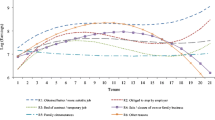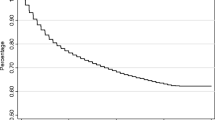Abstract
The aim of this paper is to analyse the determinants of survival in entrepreneurship in Spain. For this purpose, a binary choice model is specified and estimated, using information from the Continuous Working Life Sample drawn from the Spanish social security records. This database provides information on the work experience of entrepreneurs, which is used to differentiate between necessity and opportunity entrepreneurs. Thus, we analyse whether necessity entrepreneurs differ from opportunity entrepreneurs in terms of survival. Moreover, through the Blinder-Oaxaca decomposition for nonlinear models, proposed by Yun (2004), the key factors affecting necessity and opportunity entrepreneurs are analysed. This methodology allows us to measure the difference in probability between both groups and to look further into the causes of this difference, through the unobservable component and the characteristics component. Observable factors indicate that there is a positive difference in survival probability in favour of opportunity entrepreneurs. Unobservable factors are not significant.
Similar content being viewed by others
Notes
\( {\sum}_j^k{W}_{\Delta X}^i={\sum}_j^k{W}_{\Delta \upbeta}^i=1 \)
The CWLS has been produced since 2004. Each year, new people who are first-time contributors or pensioners are added to those who are already in the sample.
Royal Decree-Law 4/2013, of 22 February, on measures to support entrepreneurs and stimulate growth and job creation, Law 14/2013 of 27 September, supporting entrepreneurs and their internationalization and the Law 5/2015, of April 27, to promote business financing.
References
Acs, Z., & Storey, D. (2004). Introduction: Entrepreneurship and economic development. Regional Studies, 38(8), 871–877.
Amit, R., & Muller, E. (1995). ‘Push’ and ‘pull’ entrepreneurship. Journal of Small Business and Entrepreneurship, 12(4), 64–80.
Andersson, P. (2010). Exits from self-employment: Is there a native-immigrant difference in Sweden? International Migration Review, 44(3), 539–559.
Audretsch, D. B., & Keilbach, M. (2004). Does entrepreneurship capital matter? Entrepreneurship: Theory and Practice, 28(5), 419–429.
Blinder, A. S. (1973). Wage discrimination: Reduced form and structural estimate. The Journal of Human Resources, 8(7), 436–455.
Block, J. H., & Landgraf, A. (2016). Transition from part-time entrepreneurship to full-time entrepreneurship: The role of financial and non-financial motives. International Entrepreneurship and Management Journal, 12(1), 259–282.
Block, J. H., & Sandner, P. (2009). Necessity and opportunity entrepreneurs and their duration in self-employment: Evidence from German micro data. Journal of Industrial Competition Trade, 9(2), 117–137.
Borjas, G. (1986). The self-employment experience of immigrants. Journal of Human Resources, 21(4), 487–506.
Brüderl, J., & Preisendörfer, P. (1998). Network support and the success of newly founded businesses. Small Business Economics, 10(3), 213–225.
Brüderl, J., Preisendörfer, P., & Ziegler, R. (1992). Survival chances of newly founded business organizations. American Sociological Reviews, 57(2), 227–242.
Cabrer-Borrás, B., & Rico, P. (2017). Survival of entrepreneurship in Spain. Small Business Economics. https://doi.org/10.1007/s11187-017-9923-1.
Caliendo, M., & Kritikos, A. S. (2010). Start-ups by the unemployed: Characteristics, survival and direct employment effects. Small Business Economics, 35(1), 71–92.
Carrasco, R. (1999). Transition to and from self-employment in Spain: An empirical analysis. Oxford Bulletin of Economics and Statistics, 61(3), 315–341.
Clark, K., & Drinkwater, S. (2000). Pushed out or pulled in? Self-employment among ethnic minorities in England and Wales. Labour Economics, 7(5), 603–628.
Cordura, A. (2006). La motivación para emprender en España, Ekonomiaz, 62(2), 12–39.
Fairlie, R. W. (2005). An extension of the blinder-Oaxaca decomposition technique to logit and probit models. Journal of Economic and Social Measurement, 30(4), 305–316.
Fairlie, R.W., & Lofstrom, M. (2013). Inmigration and entrepreneurship. IZA Discussion Paper 7669.
Fairlie, R. W., & Robb, M. (2009). Gender differences in business performance: Evidence from the characteristics of business owners survey. Small Business Economics, 33(4), 375–395.
Fernández-Serrano, J., & Romero, I. (2014). About the interactive influence of culture and regulatory barriers on entrepreneurial activity. International Entrepreneurship and Management Journal, 10(4), 781–802.
Fertala, N. (2008). The shadow of death: Do regional differences matter for firm survival across native and immigrant entrepreneurs. Empirica, 35(1), 59–80.
Fritsch, M., Brixy, U., & Falck, O. (2006). The effect of industry, region and time on new business survival-a multi-dimensional analysis. Review of Industrial Organization, 28(3), 285–306.
Georgellis, Y., Sessions, J., & Tsitsianis, N. (2007). Pecuniary and non-pecuniary aspects of self-employment survival. The Quarterly Review of Economics and Finance, 47(1), 94–112.
Giannetti, M., & Simonov, A. (2004). On the determinants of entrepreneurial activity: Individual characteristics, economic environment, and social norms. Swedish Economic Policy Review, 11(2), 269–313.
Haapanen, M., & Tervo, H. (2009). Self-employment in urban and rural locations. Applied Economics, 41(19), 2449–2461.
Kalleberg, A. L., & Leicht, K. T. (1991). Gender and organizational performance: Determinants of small business survival and success. Academy of Management, 34(1), 136–161.
Kalnins, A., & William, M. (2014). When do female-owned businesses out-survive male-owned businesses? A disaggregated approach by industry and geography. Journal of Business Venturing, 29(6), 822–835.
Lecuna, A., Cohen, B., & Chavez, R. (2017). Characteristics of high-growth entrepreneurs in Latin America. International Entrepreneurship and Management Journal, 13(1), 141–159.
Lofstrom, M. (2002). Labor market assimilation and the self-employment decision of immigrant entrepreneurs. Journal of Population Economics, 15(1), 83–114.
Lofstrom, M., & Wang, C. (2006). Hispanic self-employment: a dynamic analysis of business ownership. IZA Discussion Paper 2101.
Maddala, G. (1983). Limited dependent and qualitative variables in econometrics. Nueva York: Cambridge University Press.
Mc Fadden, D. (1973). Conditional logit analysis of qualitative choice behavior. In P: Zarembka (Ed.), Frontiers in econometrics (pp. 104–142). New York: Academic Press.
Millan, J. M., Congregado, E., & Román, C. (2012). Determinants of self-employment survival in Europe. Small Business Economics, 38(2), 231–258.
Millán, J., Congregado, E., & Román, C. (2014). Entrepreneurship persistence with and without personnel: The role of human capital and previous unemployment. The International Entrepreneurship and Management Journal, 10(1), 187–206.
Muñoz-Bullón, F., & Cueto, B. (2011). The sustainability of start-up firms among formerly wage-employed workers. International Small Business Journal: Researching Entrepreneurship, 29(1), 78–102.
Munsasinghe, L., & Sigman, K. (2004). A hobo syndrome? Mobility, wages and job turnover. Labour Economics, 11(2), 191–218.
Nafzige, E. W., & Terrell, D. (1996). Entrepreneurial human capital and the long-run survival of firms in India. World Development, 24(4), 689–696.
Nziramasanga, M., & Lee, M. (2002). On the duration of self-employment: The impact of macroeconomic conditions. The Journal of Development Studies, 39(1), 46–73.
Oaxaca, R. L. (1973). Male-female wage differentials in urban labor markets. International Economic Review, 14(3), 693–709.
Oaxaca, R. L., & Ransom, M. (1994). On discrimination and the decompositions of wage differentials. Journal of Econometrics, 61(1), 5–21.
Oberschachtsiek, D. (2008). Founders’ experience and self-employment duration: the importance of being a ‘Jack-of-all-trades’. An analysis based on competing risks. IAB-Discussion Paper 40/2008.
Reynolds, P. D., Camp, S. M., Bygrave, W. D., Autio, E., & Hay, M. (2002). Global entrepreneurship monitor 2001 executive report. London Business School: Babson College.
Roberts, P. W., Negro, G. & Swaminathan, A. (2013). Balancing the skills sets of founders: Implications for the quality of organizational outputs. Strategic Organization, 11(1), 35–55.
Schuetze, H. J., & Antecol, H. (2006). Immigration, entrepreneurship and the venture start-up process. In S. Parker (Ed.), The Life Cycle of Entrepreneurial Ventures. International Handbook Series on Entrepreneurship, 3 (pp. 107–135). New York: Springer.
Sternberg, R., & Wennekers, S. (2005). Determinants and effects of new business creation using global entrepreneurship monitor data. Small Business Economics, 24(3), 193–203.
Taylor, M. P. (1999). Survival of the fittest? An analysis of self-employment duration in Britain. The Economic Journal, 109(454), 140–155.
Van Praag, C. M. (2003). Business survival and success of young small business owners. Small Business Economics, 21(1), 1–17.
Van Stel, A., Carree, M., & Thurik, R. (2005). The effect of entrepreneurial activity on national economic growth. Small Business Economics, 24(3), 311–321.
Wennekers, S., & Thurik, R. (1999). Linking entrepreneurship and economic growth. Small Business Economics, 13(1), 27–55.
Wennekers, S., van Stel, A., Thurik, R., & Reynolds, P. (2005). Nascent entrepreneurship and the level of economic development. Small Business Economics, 24(3), 293–309.
Yun, M. (2004). Decomposing differences in the first moment. Economics Letters, 82(2), 275–280.
Yun, M. (2005). A simple solution to the identification problem in detailed wage decompositions. Economic Inquiry, 43(4), 766–772.
Author information
Authors and Affiliations
Corresponding author
Rights and permissions
About this article
Cite this article
Belda, P.R., Cabrer-Borrás, B. Necessity and opportunity entrepreneurs: survival factors. Int Entrep Manag J 14, 249–264 (2018). https://doi.org/10.1007/s11365-018-0504-9
Published:
Issue Date:
DOI: https://doi.org/10.1007/s11365-018-0504-9




